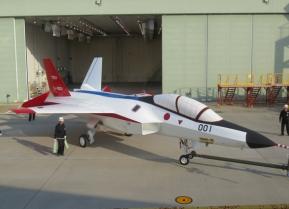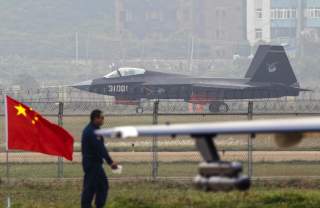Stealth Fighters, Carrier-Killer Missiles and Deadly ICBMs: How China's Military Is Evolving
And this one report breaks it all down.
TAIPEI - The U.S. Defense Intelligence Agency’s 125-page report, “China Military Power – Modernizing a Force to Fight and Win,” details China’s military modernization efforts with an emphasis that the People’s Liberation Army (PLA) is not a “national army” but a military arm of the Chinese Communist Party that exists to guarantee the CCP’s survival.
To improve the military’s ability to protect the Party from losing power, the CCP has been generous in providing the PLA with an increased budget of 10 percent per year from 2000 to 2016.
In late 2015, President Xi Jinping unveiled the most substantial PLA reforms in thirty years, making the military “a leaner, more lethal force capable of conducting the types of joint operations that it believes it must master to compete with the US military.”
The structural reforms established a separate PLA Army (PLAA) headquarters and elevated China’s Rocket Force (PLARF), Air Force (PLAAF) and Navy (PLAN) on an equal footing. The PLAA was once the dominate service in the military and the move to establish more independent commands was part of Xi’s plan to encourage jointness across services. The reforms will be finished by 2020.
In Xi’s speech before the 19th Party Congress in October 2017, he called on the PLA to “prepare for military struggle in all strategic directions,” and said there were three developmental benchmarks for the PLA: becoming a mechanized force with increased informatized and strategic capabilities by 2020, a fully modernized force by 2035, and a worldwide first-class military be mid-century.
Though the objective is to expand military prowess on the world stage, China’s primary threat perceptions are still sovereignty and the domestic security issues it believes are a threat to the Party. These remain Taiwan, Uighur and Tibetan problems, and challenges to its control of disputed areas in the South China Sea—though authoritative documents also highlight the Korean Peninsula and border disputes with India.
The South China Sea (SCS) has become a controversial international issue. China has managed to occupy seven reefs in the Spratly Islands and has established “outposts” on about sixty others. The Japanese controlled Senkaku Islands in the East China Sea is also an area of contention.
Officially, the Chinese use maritime law enforcement ships, with the PLAN serving in a protective position, in an attempt not to give the overt impression the SCS seizures are military in design, yet the Chinese have fielded military aircraft, air defense systems and radar on the occupied islets. The same tactic is used with the Senkaku Islands with Chinese Coast Guard and fishing vessels conducting incursions into the contiguous zone around the island, while the PLAN stays within intimidation range.
The PLAN has chosen to base the Marine Corps not across from Taiwan in the Eastern Theater Command, but instead in the Southern Theater Command and Northern Theater Command to deal with island disputes in the South China Sea and the East China Sea. They are “tasked with seizing and consolidating beachheads.” The seven brigades consist of 28,000-35,000 Marines evenly divided among the brigades. The PLANMC does not yet have an organic air assault element and still must rely on the PLAN and PLAA for helicopter transport and close air support. Combat vehicles are the ZBD-05 Amphibious Infantry Fighting Vehicle and the ZLT-05 Amphibious Assault Vehicles.
Though virtually nothing is mentioned about Taiwan, the report makes obvious references to the PLAN’s ability to ferry troops with new air-cushioned utility landing craft capable of carrying troops and tanks. The Type 071 Yuzhao amphibious transport docks, built since 2005, and continuing, it will also be supplemented with a new Type 075 landing helicopter assault ship with a full flight deck for helicopters.
The PLAN has gone full tilt in recent years cranking out new corvettes, frigates and destroyers. A new guided-missile cruiser, Type 055, “will be one of the most advanced and powerful ships in the world, boasting a large array of advanced-capability weapons and sensors developed domestically.” The 055 has 112 vertical-launch cells for mixed munitions. Submarine numbers are also increasing. By 2020 PLAN will have about seventy submarines in all varieties evenly disputed between the three theaters.
The PLAN has relied heavily on the H-6 (Tu-16) medium-range bomber for decades now for maritime strike missions but has modified them to carry anti-ship cruise missiles (H-6K). Though the military plans to introduce new long-range stealth bombers for strategic missions in the foreseeable future.
At present, the PLAAF has the largest air force in the region and the third largest in the world, with more than 2,500 total aircraft of which 1,700 are combat aircraft. Though it has many 2nd and 3rd Generation fighters, within the next several years the PLAAF will field a majority of at least 600 4th Generation fighters. This does not include the J-31/J-20 5th Generation fighters now being finalized.
In 2017 the PLAAF did lose operational control over the 15th Airborne Corps when it was renamed the PLA Airborne Corps. Though the report does not refer to Taiwan, many inside the military in Taiwan expect this force to be used early in a campaign to take the island’s critical targets. According to the report, the new Airborne Corps consists of six brigades, a special operations brigade, aviation brigade, and support brigade. The report quotes PLA doctrinal writings: “cut across ground defense lines and topographical obstacles to unfold attacks directly inside the enemy disposition.” The report further states that these operations are designed to support main-force operational efforts, seize and hold key targets and areas in the enemy’s depth, such as airfields and bridges, block an enemy’s retreat, block reinforcement by enemy reserve forces, and conduct raids on key targets in the enemy’s depth.
The only criticism of the report that could be had, is that the authors could have referenced video evidence coming out of China showing airborne units practicing assaulting Taiwan’s presidential building. China has constructed a 1:1 mock-up of the building in Western China to simulate realistic training. Local Taiwan military experts have said that Chinese airborne forces expect to land helicopters at Chiang Kai-shek Memorial (385x126 yards) and then fight their way up Ketagalan Boulevard (630 yards) before taking the building. Preventing the president from reaching the Hengshan Defense Command bunker in Dahzi is critical for a quick victory for China.
Missiles and nuclear weapons have proliferated in China. Though the PLARF and PLAN have had nuclear-capable delivery systems, in 2017 the PLAAF was assigned a nuclear mission with expectations that its future strategic bomber project will fulfil that role. The bomber would provide China its first credible nuclear triad of delivery systems dispersed across land, sea and air.
Though China has maintained a “no first use” policy, there “is some ambiguity.” The report notes that some within the PLA have said that the policy would not apply “if an enemy’s conventional attack threatened the survival of China’s nuclear force or of the regime itself.”
China has developed a new missile for possible nuclear strike options. Unlike the United States, China mixes ballistic missile missions with both conventional and nuclear warhead capabilities. Something that the United States has in the past refrained from doing to avoid confusion with the former Soviet Union over what is and is not a preemptive nuclear strike.
In 2015 Beijing revealed the new DF-26 intermediate-range ballistic missile with both conventional and nuclear warhead capabilities, not to mention the second ballistic missile (DF-21D) allegedly capable of anti-ship missile capabilities. According to the report, China has between 75-100 intercontinental ballistic missiles capable of reaching the United States. It is also developing a new road-mobile MIRV-capable DF-41 that will make it difficult for the United States to locate and destroy before firing.
China has also, according to the report, improved its advanced underground facility (UGF) program after learning that the United States was able to penetrate weaker facilities with bunker-buster munitions during the 1991 Persian Gulf War.
Overall the DIA report is an unclassified regurgitation of open source material, but as a Taiwan military official said after reading the report: “the report provides endorsements and confirmation of the open source information it draws from.”
Wendell Minnick is a Taipei-based journalist who has spent two decades covering military and security issues in Asia, including one book on intelligence and over 1,500 articles. From 2006-2016, Minnick served as the Asia Bureau Chief for Defense News, a Washington-based defense weekly newspaper. He has edited over ten books on Chinese military equipment.
Image: Reuters.


